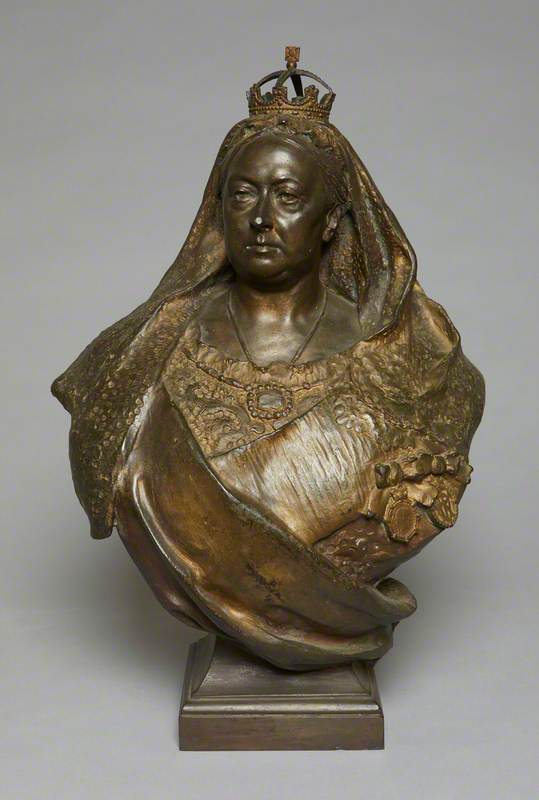
Queen Victoria (1819–1901) 1902
Edward Alfred Briscoe Drury (1856–1944)
English Heritage, Osborne House
Text source: A Dictionary of Modern and Contemporary Art (Oxford University Press)
1856–1944
British

Queen Victoria (1819–1901) 1902
Edward Alfred Briscoe Drury (1856–1944)
English Heritage, Osborne House
Text source: A Dictionary of Modern and Contemporary Art (Oxford University Press)
Edward Alfred Briscoe Drury [commonly known as Alfred Drury] was born in Islington, London on 11 November 1856. By 1871 he had moved with his family to Oxford where his father was a beer house keeper (publican). After attending Oxford School of Art, he studied at the he National Art Training School in South Kensington, London, where he was taught by Francis Wollaston Thomas Moody (1824-1886), Jules Dalou (1838-1902), and Édouard Lantéri (1848-1917), from c.1877 to 1881. During his time at the National Art Training School, Drury won a Gold Medal in the National Art Competition on three occasions - 1879, 1880 and 1881. After leaving the school in 1881, he worked as Dalou's assistant at his studio in Paris for four years.
Following his return to London in 1885 he worked briefly as an assistant to the Austrian-born sculptor Joseph Edgar Boehm (1834-1890). He exhibited for the first time that year at the Royal Academy in London and continued to do so frequently for the next sixty years. During a long career he also exhibited at the Baillie Gallery, New Gallery, Royal Society of Portrait Painters, Royal Society of British Artists, Royal Institute of Oil Painters, Royal Institute of Painters in Water Colours, and International Society of Sculptors, Painters and Gravers in London; Leeds City Art Gallery; Walker Art Gallery in Liverpool; Manchester City Art Gallery; Royal Birmingham Society of Artists; Aberdeen Artists' Society; Royal Glasgow Institute of the Fine Arts; the Royal Scottish Academy in Edinburgh; and at the Paris and Brussels Salons. He participated in the International Exhibitions in Brussels in 1897; Paris in 1900, at which he was awarded a Gold Medal for his sculptural group Circe; Glasgow in 1901; and Dublin in 1907
Drury worked primarily as an architectural and portrait sculptor. Notable among his work were the sculptural group Circe (exhibited at the Royal Academy 1893); Griselda, a bronze bust (exhibited at the RA in 1896 and purchased that year by the Chantry Bequest); The Age of Innocence, bronze bust, exhibited at the RA in 1897); monument to Penn Symons for Victoria Gardens in Saltash, Cornwall (1901); Morning and Evening, eight figurative street lamps for Leeds City Square (1903); statue of Joseph Priestley for Leeds City Square (1903); statue of Queen Victoria for Guildhall Square, Portsmouth, Hampshire (1903); statue of Queen Victoria, for Princes Way, Bradford (1904); bust of Lord Byron at Nottingham Castle (1904); statue of Queen Victoria for Kent Terrace, Wellington, New Zealand (1905); statues of Queen Victoria and Prince Albert for the façade of the Victoria & Albert Museum (1906); statue of Bishop Richard Hooker for Cathedral Close, Exeter (1907); statue of Spencer Cavendish, 8th Duke of Devonshire for King Edward's Parade, Eastbourne, Sussex (1910); statue of Elizabeth Fry for the Old Bailey law courts, London (1913); statue of Edward VII for Fitzalan Square, Sheffield (1913); statue of Edward VII for Union Terrace, Aberdeen (1914); statue of Charles Kingston for Victoria Square, Adelaide, South Australia (1915); and statue of Joshua Reynolds for the courtyard of Burlington House, London (1931).
Drury was commissioned to make several Boer War and World War One war memorials. These included for Clifton College, Bristol (1904); Queens Gardens, Warrington (1907); Royal Exchange, London (1920); St Mary's Church, Kidderminster (1922); Parliament Square, Hertford, Hertfordshire (1922); Grove Park, Weston-super-Mare, Somerset (1922); and Denstone College, Uttoxeter (1925).
During World War One he designed a patriotic medallion entitled "Lest We Forget" (1916). In addition to his work as a sculptor, Drury occasionally exhibited paintings and drawings.
Drury was elected an Associate of the Royal Academy (ARA) in 1900; a Royal Academician (RA) in 1913; and a Fellow of Royal Society of British Sculptors in 1923. He was also elected a member of the Chelsea Arts Club in 1891; Art Workers Guild in 1899; and the International Society of Sculptors, Painters and Gravers in 1899. He was President of the Royal Birmingham Society of Artists (PRSBA) from 1913 to 1934; and Royal Society of British Sculptors (PRBS) in 1919. 1n 1932 he was awarded the Royal Society of British Sculptors Silver Medal for his statue of Joshua Reynolds
Drury lived at 50 Glebe Place, Chelsea, London from 1890 to 1893; 6 Gunter Grove, Fulham Road, London from 1893 to c.1913; and Lancaster Lodge, 40 Lancaster Road, Wimbledon, London from 1913 until his death on 24 December 1944.
Text source: Art History Research net (AHR net)